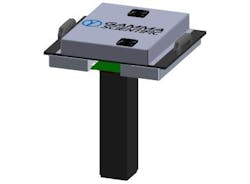Programmable LED light source replaces halogen calibration sources for wafer-level image sensor and detector testing
A digitally programmable, color-tunable calibrated light source introduced by Gamma Scientific (San Diego, CA) is a drop-in addition to commercially available systems for wafer-level testing of CCD and CMOS sensors. Called the RS-7-4 SpectralLED, the tunable LED light source bolts directly onto existing image-sensor testers from manufacturers such as Teradyne and National Instruments.
It can also be adapted to test head manipulators and handler instrumentation custom-built by end users. It can then be programmed to deliver an arbitrary spectral power distribution of visible light -- for example, reproducing the output of blackbody sources and various standard CIE illuminants, over a wide range of output luminance. This enables rapid automation for accurate characterization of detector dynamic range, uniformity, linearity and spectral responsivity, and also facilitates identification of pixel defects.
The LED-based device offers advantages over traditional calibration light sources for image-sensor testing, such as tungsten halogen incandescent bulbs, says Gamma Scientific. For example, it offers a longer calibrated stable lifetime than tungsten sources, which are unstable over their relatively brief operational lifetimes. In addition, the color temperature and spectral power distribution of the RS-7-4 can be rapidly varied through software control, and the output is linear over its output range. None of this is true of tungsten bulbs.
The RS-7-4 uses a large number of discrete LED channels to enable accurate reproduction of a specific illuminant. It also uses highly stabilized DC drive current circuitry, rather than pulse width modulation (PWM), to vary output luminance. This is critical when testing high-speed silicon detectors, which can time-resolve PWM signals, thus causing measurement errors.
Source: Gamma Scientific
